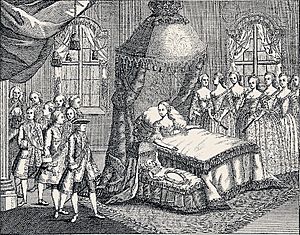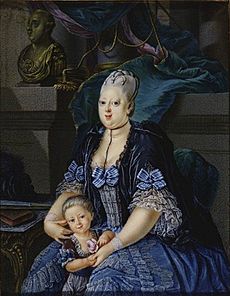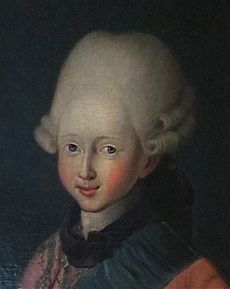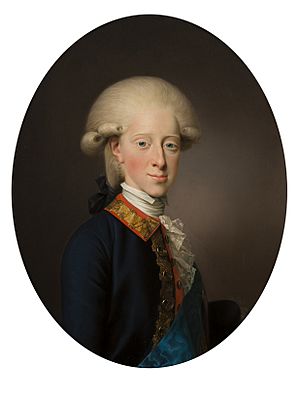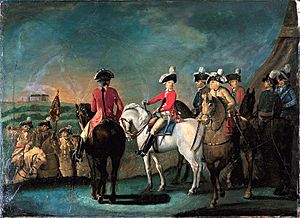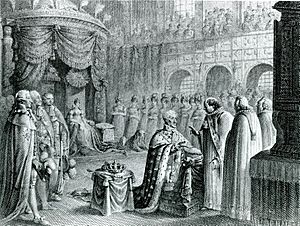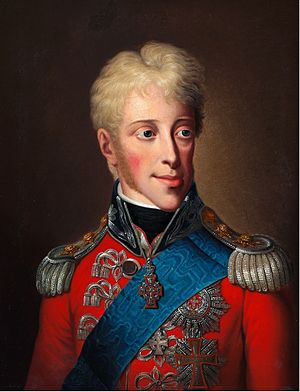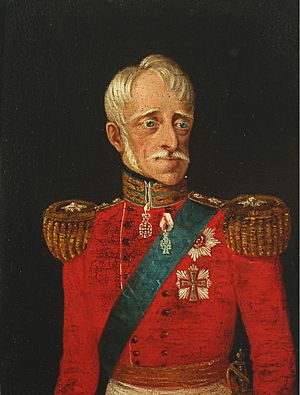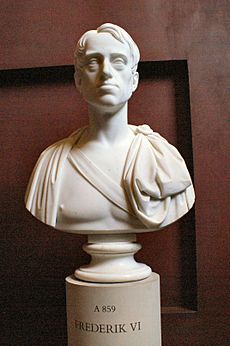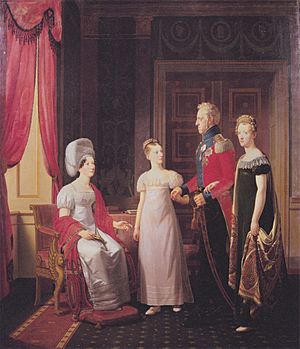Frederick VI of Denmark facts for kids
Quick facts for kids Frederick VI |
|
|---|---|

Portrait by Friedrich Carl Gröger, 1808
|
|
| King of Denmark (more...) | |
| Reign | 13 March 1808 – 3 December 1839 |
| Coronation | 31 July 1815 Frederiksborg Palace Chapel |
| Predecessor | Christian VII |
| Successor | Christian VIII |
| Chief Ministers |
See list
Christian Günther von Bernstorff
Frederik Moltke Joachim Godske Moltke Ernst Heinrich von Schimmelmann Otto Joachim Moltke |
| King of Norway | |
| Reign | 13 March 1808 – 7 February 1814 |
| Predecessor | Christian VII |
| Successor | Christian Frederick |
| Crown Prince-Regent of Denmark-Norway | |
| Tenure | 14 April 1784 – 13 March 1808 |
| Predecessor | Hereditary Prince Frederick |
| Monarch | Christian VII |
| Born | 28 January 1768 Christiansborg Palace, Copenhagen |
| Died | 3 December 1839 (aged 71) Amalienborg Palace, Copenhagen |
| Burial | Roskilde Cathedral |
| Spouse |
Marie of Hesse-Kassel
(m. 1790) |
| Issue | Caroline, Hereditary Princess of Denmark Vilhelmine, Duchess of Schleswig-Holstein-Sonderburg-Glücksburg |
| House | Oldenburg |
| Father | Christian VII of Denmark |
| Mother | Caroline Matilda of Great Britain |
| Religion | Lutheran |
Frederick VI (Danish and Norwegian: Frederik; 28 January 1768 – 3 December 1839) was the King of Denmark from 1808 to 1839. He was also the King of Norway from 1808 to 1814, making him the last king of Denmark–Norway.
Before becoming king, Frederick served as a regent for his father, King Christian VII, who was mentally ill. This period lasted from 1784 until 1808. During this time, he was known as the "Crown Prince Regent." Frederick chose God and the just cause as his motto. After his reign, all Danish monarchs have chosen mottos in Danish instead of the traditional Latin.
Frederick VI had no sons who survived to adulthood. Because of this, his half-first cousin, Christian, became the next King of Denmark.
Contents
Early Life and Family
Birth and Childhood
Frederick VI was born on January 28, 1768, at Christiansborg Palace in Copenhagen. He was the first child of King Christian VII and Queen Caroline Mathilde of Denmark and Norway. He was born into the House of Oldenburg, the royal family that had ruled Denmark since the 1400s.
Frederick became the crown prince at birth because he was the king's oldest son. Two days later, he was baptized and named after his grandfather, King Frederick V.
Growing Up at Court
During Frederick's childhood, his father, King Christian VII, suffered from increasing mental illness. This led to power struggles at the Danish court. Johann Friedrich Struensee, the king's doctor, became very powerful. From 1770 to 1772, Struensee was basically in charge of the country.
Struensee also became close with Frederick's mother, Queen Caroline Mathilde. He earned her trust by successfully protecting Crown Prince Frederick from a smallpox outbreak in 1769.
Struensee believed in new ideas about education. He wanted young Frederick to learn by playing and exploring, rather than just studying from books. Frederick was raised at Hirschholm Palace and learned by playing with two boys who were not from noble families.
In 1772, Struensee was removed from power in a sudden event at the palace. He was later executed. Queen Caroline Mathilde was sent away, and four-year-old Frederick never saw his mother again. After Struensee was gone, Frederick's half-uncle, Hereditary Prince Frederick, became regent. However, the real power was held by his step-grandmother, Queen Dowager Juliana Maria.
Crown Prince Regent
Taking Control in 1784
As Crown Prince Frederick grew older, he wanted to take control of the government. Even though he was getting older, the government kept delaying his confirmation, which would officially make him an adult.
However, when Frederick turned 16 in 1784, his confirmation could no longer be put off. On April 14, 1784, he took full power as regent. He removed the ministers who were loyal to his step-grandmother. He continued to rule Denmark-Norway in his father's name until his father died in 1808.
Important Changes
During his early years as regent, Frederick introduced many important changes. He worked with his chief minister, Andreas Peter Bernstorff, to bring about liberal reforms. One of the most significant changes was the abolition of serfdom in 1788. This meant that farmers were no longer tied to the land and could move freely.
Marriage and Children
Frederick chose to marry his first cousin, Marie Sophie of Hesse-Kassel. They were married in Gottorp on July 31, 1790. They had eight children together, but sadly, six of them died when they were very young.
Their two daughters who grew up were Princess Caroline and Princess Vilhelmine. Neither of them had children. Since Frederick had no sons who survived, his half-cousin, Christian, later became king.
The English Wars
During Frederick's time as regent, Denmark faced conflicts with Great Britain. The British were concerned about Denmark's neutral shipping. This led to two British attacks on Copenhagen: the Battle of Copenhagen in 1801 and the Battle of Copenhagen in 1807. The fighting continued in the Gunboat War until 1814.
King of Denmark and Loss of Norway
On March 13, 1808, Frederick's father, King Christian VII, died. Frederick finally became the King of Denmark and Norway at the age of 40.
During the Napoleonic Wars, Frederick tried to keep Denmark neutral. However, after the British attacked Copenhagen in 1807, he allied Denmark-Norway with Napoleon. Even after Napoleon's defeat in Russia in 1812, Frederick refused to switch sides. Some historians believe he was stubborn, but others suggest he stayed with Napoleon to protect Norway. Norway depended on grain imports and was a target for Sweden. Frederick hoped that a large international meeting after the war would help protect Denmark's interests, especially in Norway.
After Napoleon's defeat in 1814, Denmark lost Norway as a result of the Treaty of Kiel. After this, Frederick VI became more strict in his rule. He moved away from the liberal ideas he had supported as a prince regent. There was censorship and opposition was suppressed. The country's economy was also struggling, making this a difficult time.
However, by the 1830s, the economy started to improve. In 1834, the king reluctantly allowed the creation of regional assemblies. These assemblies could give advice, but they didn't have much power. This change, however, unintentionally made relations between Danes and Germans in Schleswig worse, as their assembly became a place for arguments between the two groups.
Later Life and Legacy
Frederick VI was interested in astronomy. In 1832, he offered gold medals to anyone who discovered a comet using a telescope. This tradition continued until 1850.
In 1827, he granted a special permission for Serampore College in Danish India to become a university. This allowed it to give out degrees, making it the third Danish university after those in Copenhagen and Kiel.
Frederick VI died at the age of 71 at Amalienborg Palace in Copenhagen. He was buried in Roskilde Cathedral. He reigned over Denmark for a total of 55 years: 24 years as crown prince regent and 31 years as king.
Since Frederick VI had no sons who survived him, his half-first cousin, Christian, became the next King of Denmark. The University of Oslo in Norway was originally named The Royal Frederick University in his honor.
Descendants
Frederick VI and his wife Marie of Hesse-Kassel had eight children. Six of them died very young. Their two daughters who lived to adulthood were:
- Caroline (born 1793, died 1881), who married her father's first cousin, Frederick Ferdinand of Denmark. They had no children.
- Vilhelmine Marie (born 1808, died 1891), who married twice. Her first husband was her second cousin, Frederick (who later became Frederick VII of Denmark). They divorced, and she then married Karl, Duke of Schleswig-Holstein-Sonderburg-Glücksburg. She had no children from either marriage.
Images for kids
See also
 In Spanish: Federico VI de Dinamarca para niños
In Spanish: Federico VI de Dinamarca para niños


